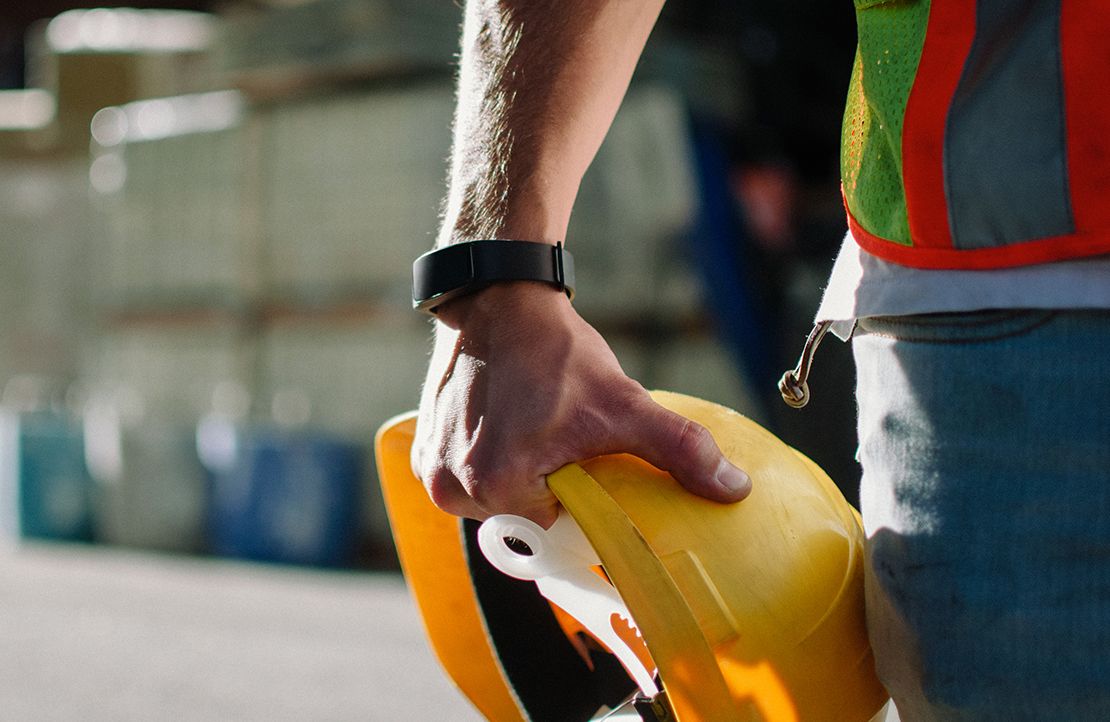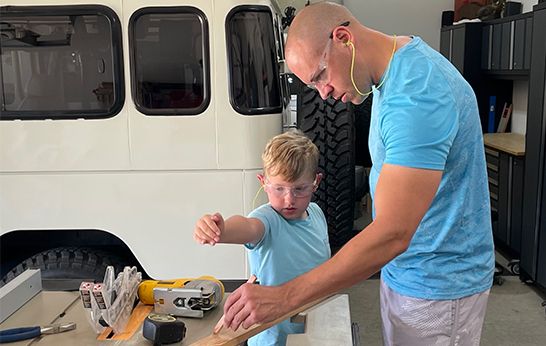

Sign In
Welcome! Sign In to personalize your Cat.com experience
If you already have an existing account with another Cat App, you can use the same account to sign in here
Register Now
One Account. All of Cat.
Your Caterpillar account is the single account you use to log in to select services and applications we offer. Shop for parts and machines online, manage your fleet, go mobile, and more.
Account Information
Site Settings
Security
How to Develop an At-Home Safety Plan
Are you prepared for safety threats that you may face at home? From tornadoes and fires to medical emergencies, it’s important to be prepared. Get started with these tips to develop an at-home safety plan.
By Caterpillar | Updated: June 3, 2022
You know how to keep yourself safe on a work site, but what about the threats that you face at home? There are a wide range of hazards and risks at home, from tornadoes and fires to medical emergencies and winter storms. Just as you have a comprehensive safety plan at work, you also need one for your family.
Here at Caterpillar, we're big on cultivating safety in all aspects of life — especially since almost 90% of preventable medically consulted injuries actually occur off the job. Just like at work, one of the best ways to prevent injuries at home is to develop a safety plan and have regular conversations about how to be safe with your family. Let's take a closer look at how to make a safety plan for your home.
Tips for Developing an At-Home Safety Plan
Below are some steps to create a general home safety plan. This is not all-inclusive, but a good place to begin. Remember to factor in unique needs, like accommodations for disabilities and pets.
Below are some steps to create a general home safety plan. This is not all-inclusive, but a good place to begin. Remember to factor in unique needs, like accommodations for disabilities and pets.
1. PLAN YOUR EVACUATION ROUTES, SHELTER PLANS AND MEETUP LOCATIONS
Your home safety plan should include an evacuation and take shelter plan. For each scenario, document your plan and evacuation location and practice it with your family. Below are a few scenarios to include in your plan:
- Indoors: An indoor shelter plan is necessary for situations like tornadoes, power outages, and winter storms. Tornadoes might call for sheltering in a windowless room, while winter storms are best weathered in well-insulated spaces. Ready.gov has detailed tips for planning your shelter location.
- Outdoors: Have a plan to quickly evacuate your home in case of a fire, gas leak or other emergency and identify a meet-up location outdoors. This space should be a sufficient distance from the house. Make sure anyone living in an upper level can get to the ground with a fire escape ladder.
- Out-of-neighborhood: Situations like wildfires, flooding or hurricanes may require you to evacuate your neighborhood or city. Make sure you have multiple routes to evacuate and establish a safe place to go, such as a family member's house, a Red Cross shelter, or a hotel — pet-friendly if needed.
- Discuss other potential situations with your family that may require a dedicated meet-up location or shelter. Plan accordingly.

A great way to get your family involved is to have the kids help in creating their route and tracing it on a diagram. This exercise offers visualization and a handy reminder to put on the wall. Be sure to think proactively when planning, just like you do on the job, and run through the drills frequently.
2. Create an Emergency Preparedness Kit
The best time to stock up on emergency supplies is before there's an emergency. Every family should have an emergency preparedness kit and everyone in the family should know where it’s stored. Depending on where you live, you may need additional items, but the list below is a good place to start:
- One gallon of clean water for each person per day and a water filter.
- Shelf-stable food and a can opener.
- Flashlights (choose long-lasting LED models and don't forget batteries).
- Important medications.
- Toiletries.
- Cash.
- Battery-powered radio and spare batteries.
It's also a good idea to have basic Personal Protective Equipment (PPE) on hand. Should you find yourself navigating through rubble from a natural disaster (think downed trees, broken glass, etc) you'll be glad you planned ahead. Safety glasses, work gloves, dust masks, and closed-toed shoes are the fundamentals.
You'll also want a first-aid kit, with items like gauze, trauma shears, tourniquets, antiseptic wipes, emergency blankets, breathing barriers and cold compresses. Approximately 48% of Americans don't have these kinds of emergency supplies, but you can make sure you're not one of them.
3. Set Up an Emergency Warning System and Communication Plan
Enable Emergency Alerts on Your Phone: While sudden emergency alerts on your phone might be startling, they're super-valuable in times of emergency, so make sure you have them enabled. Make sure you know the difference between a “watch” and a “warning” and how to react. A battery-powered radio can also enable you to tune into Emergency Alert Systems.
Hard Copy of Emergency Contacts: Ever lose your phone and find you can't remember phone numbers of friends and family? Us too. That's a problem during an emergency. Plan for it with a manual back up: Create a paper contact card for your family members to carry with them that contains everyone's phone number, along with alternative contact numbers, like school and work, and numbers for emergency services.
These contact cards can be especially important to help first responders understand the situation if any member of your family doesn't speak the dominant language of the area or is unable to communicate.
You may also want to document information about daily medications, dietary needs, frequent locations visited, disabilities, pets, and care responsibilities, such as looking after an elderly relative.
4. Involve the Whole Family in Your Home Safety Plan
On the job site, you know how important it is to have a culture of safety. The same applies to the home. One way to build a safety culture and mindset is to engage the whole family in safety drills, planning and training. Teach kids about 911 - how and when to call (and when not to).
Take a CPR class together as a family.
Make sure kids understand basic safety equipment at home.
- If a child has a fire escape ladder in their room, have them practice with it during drills.
- Discuss smoke and carbon monoxide detectors, test the alarm beeper so they know what it sounds like and discuss what to do when they go off.
- Teach kids how and when to use fire extinguishers and make sure they are set up at appropriate and accessible locations, like the kitchen.
Walk around the house and garage and identify other items that could pose a threat like power tools, lawn care equipment, fireplaces, household chemicals and pools. Discuss safety measures with your family and, if needed, put protective equipment systems in place (like locks, gates, etc).
Remember that complacency is your enemy when it comes to safety. Don't just do the drills once and assume everyone will remember - instead set monthly reminders on your calendar to have a safety discussion and practice your home safety plan.
Prepare for Emergency Situations
Think about and prepare for specific emergency situations where you live and discuss safety procedures with family. If you live in sunny California, you'll want to include earthquakes and wildfires in your at-home safety plan strategy. Someone in the Midwest might be more concerned about tornadoes and winter storms. If you travel to any of these places, it's especially important to educate your family and have a plan in advance, as you're likely unfamiliar with the area and local hazards.
Here are a few things to consider preparing for:
- Fire: Teach basic fire safety, including "stop, drop and roll," touching a door before opening it and crawling under smoke. When creating an effective fire safety plan for your home, make sure everyone in the house knows their evacuation routes and understands not to waste time grabbing valuables.
- Earthquakes: Bolt any tall, heavy items to the wall and teach the principle "drop, cover and hold." Don't depend on a doorway, and instead look for a sturdy piece of furniture.
- Tornadoes: Find a well-built room with no windows in the event of a tornado - preferably one in a basement. If in a high-rise building, go to the hallway. Mobile home residents should try to go to a nearby building as soon as a watch is announced. Learn more about tornado safety here.
- Wildfires: In addition to your home fire safety plan, have an evacuation bag ready for everyone, including pets. Prepare these bags with items like clothes and hard-to-replace items such as medications and important documents. Don't wait until the last minute to evacuate, as fires can move rapidly and you don't want to get stuck in a traffic jam of people evacuating.
- Extreme temperatures: Whether dad's mowing the lawn on a hot day or the kids are making snowmen in the winter, make sure everyone understands the signs of heat exhaustion and frostbite. Better yet, don't risk it - check the weather ahead of time and change plans if temperatures are too extreme. You can also use OSHA's Heat Safety app to gauge risk.
- Power outages: Power outages often occur during extreme weather. When preparing your home for extreme conditions, keep plenty of clean water, blankets and heating pads on hand. If you depend on medical equipment, make sure you have suitable back-up power. Pay attention to community resources during these events, as you can often find emergency cooling or heating centers available.
- Poisonous insects, spiders, snakes and plants: Visit this CDC site and learn how to identify them, strategies to avoid them and what to do if you encounter them.
Staying Safe on the Job and at Home with Caterpillar
Safety culture is key in your personal safety plan at home and on the job. Caterpillar Safety Services offers a variety of Safety Services to help improve safety in industrial environments.
Learn more about Safety Services today.




